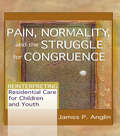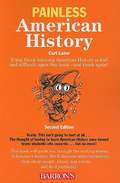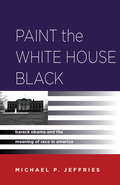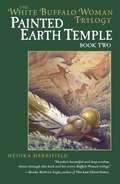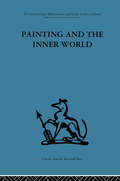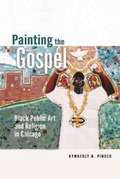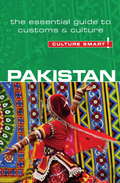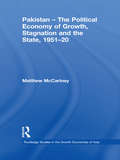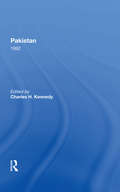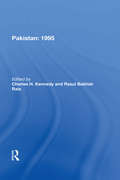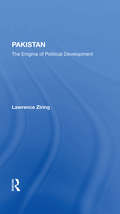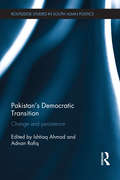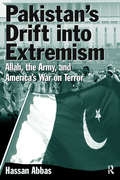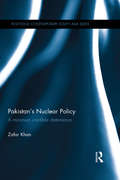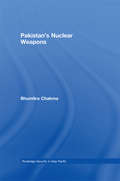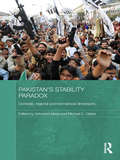- Table View
- List View
Pain, Normality, and the Struggle for Congruence: Reinterpreting Residential Care for Children and Youth
by James P AnglinLearn what children living in group homes need most! Pain, Normality, and the Struggle for Congruence: Reinterpreting Residential Care for Children and Youth presents the results of a 14-month study of 10 staffed group homes in British Columbia. The book uses grounded theory to construct a theoretical model that speaks to the primary challenge care workers face each day-responding to pain and pain-based behavior in residents. It combines participant observations, transcribed interviews, and document analysis to develop a core theme of congruence, several major psychosocial processes, and 11 interactional dynamics identified as being fundamental to group home life. The study brings to light several neglected aspects of residential care and proposes new directions in policy development, education, practice, and research to create an integrated and accessible framework for understanding group home life for youths. Pain, Normality, and the Struggle for Congruence: Reinterpreting Residential Care for Children and Youth is a full and rigorous examination of the theoretical and empirical underpinnings of residential group care. The study-conducted during a time of heightened sensitivity to the rights of children and increased emphasis on accountability and outcome measurement-reveals a core theme of congruence, focusing on consistency, reciprocity, and coherence. The book examines the major elements of this theme, including: creating an extra-familial living environment developing a sense of normality listening and responding with respect establishing a structure, routine, and expectations offering emotional and developmental support respecting personal space and time discovering potential communicating a framework for understanding and much more! Pain, Normality, and the Struggle for Congruence: Reinterpreting Residential Care for Children and Youth provides professionals concerned with the development and treatment of children and young people with a unique understanding of group home life and work. From the Foreword, by Dr. Barney Glaser: I am honored and delighted to be asked by Jim Anglin to write the foreword to this grounded theory text... The purpose of this grounded theory is to construct a theoretical framework that would explain and account for well-functioning staffed group homes for young people, that in turn could serve as a basis for improved practice, policy development, education and training, research, and evaluation. THE READER WILL SEE THAT ANGLIN HAS ACHIEVED HIS GOAL WITH ADMIRABLE SUCCESS. . . . HIS GROUNDED THEORY TRULY MAKES A SCHOLARLY CONTRIBUTION TO THE LITERATURE.
Pain, Parties, Work: Sylvia Plath in New York, Summer 1953
by Elizabeth Winder“An illuminating biography . . . which floods clarifying light on a chapter of the poet’s early life that Plath painted in jaundiced tones in The Bell Jar.” —The New York Times, Sunday Styles FeatureOn May 31, 1953, twenty-year-old Sylvia Plath arrived in New York City for a one-month stint at “the intellectual fashion magazine” Mademoiselle to be a guest editor for its prestigious annual college issue. Over the next twenty-six days, the bright, blond New England collegian lived at the Barbizon Hotel, attended Balanchine ballets, watched a game at Yankee Stadium, and danced at the West Side Tennis Club. She typed rejection letters to writers from The New Yorker and ate an entire bowl of caviar at an advertising luncheon. She stalked Dylan Thomas and fought off an aggressive diamond-wielding delegate from the United Nations. She took hot baths, had her hair done, and discovered her signature drink (vodka, no ice). Young, beautiful, and on the cusp of an advantageous career, she was supposed to be having the time of her life.Drawing on in-depth interviews with fellow guest editors whose memories infuse these pages, Elizabeth Winder reveals how these twenty-six days indelibly altered how Plath saw herself, her mother, her friendships, and her romantic relationships, and how this period shaped her emerging identity as a woman and as a writer. Pain, Parties, Work—the three words Plath used to describe that time—shows how Manhattan’s alien atmosphere unleashed an anxiety that would stay with her for the rest of her all-too-short life.Thoughtful and illuminating, this captivating portrait invites us to see Sylvia Plath before The Bell Jar, before she became an icon—a young woman with everything to live for.
Painless American History (Painless Series) (2nd Edition)
by Curt LaderThe grand drama of American history is covered for middle school and high school students, starting with Columbus's landing, and continuing through European colonization, United States independence, and the nation's development and growth to become the leading world power. This edition has been updated to include important events of the twenty-first century. Titles in Barron's Painless Series are written especially for middle school and high school students who are having a difficult time with a specific subject. In many cases, a student is confused by the subject's complexity and details. Still other students simply finds a subject uninteresting, an attitude that usually results in lower grades. Painless titles offer informal, student-friendly approaches to each subject, emphasizing interesting details, supplementing the text with amusing insights, and outlining potential pitfalls clearly and step by step. Students begin to understand how disparate details all fit together to form a clear picture. Timelines, ideas for interesting projects, and "Brain Tickler" quizzes in many of these titles help to take the pain out of study and improve each student's grades.
Paint the White House Black: Barack Obama and the Meaning of Race in America
by Michael P. JeffriesBarack Obama's election as the first black president in American history forced a reconsideration of racial reality and possibility. It also incited an outpouring of discussion and analysis of Obama's personal and political exploits. Paint the White House Blackfills a significant void in Obama-themed debate, shifting the emphasis from the details of Obama's political career to an understanding of how race works in America. In this groundbreaking book, race, rather than Obama, is the central focus. Michael P. Jeffries approaches Obama's election and administration as common cultural ground for thinking about race. He uncovers contemporary stereotypes and anxieties by examining historically rooted conceptions of race and nationhood, discourses of "biracialism" and Obama's mixed heritage, the purported emergence of a "post-racial society," and popular symbols of Michelle Obama as a modern black woman. In so doing, Jeffries casts new light on how we think about race and enables us to see how race, in turn, operates within our daily lives. Race is a difficult concept to grasp, with outbursts and silences that disguise its relationships with a host of other phenomena. Using Barack Obama as its point of departure,Paint the White House Blackboldly aims to understand race by tracing the web of interactions that bind it to other social and historical forces.
Painted Earth Temple
by Heyoka MerrifieldIn this second volume of the White Buffalo Woman Trilogy, Heyoka Merrifield transports us back to ancient Europe as a mythical tribe of hunter-gatherers is forced on an odyssey away from Gaia's land and into the New World. Painted Earth Temple reveals the rites and rituals of a culture of antiquity showing us that their traditions have never been more pertinent than in today's modern age. The Native American saga continues in Lying Down Mountain, the volume in the trilogy.
Painted Pomegranates and Needlepoint Rabbis: How Jews Craft Resilience and Create Community (Where Religion Lives)
by Jodi Eichler-LevineExploring a contemporary Judaism rich with the textures of family, memory, and fellowship, Jodi Eichler-Levine takes readers inside a flourishing American Jewish crafting movement. As she traveled across the country to homes, craft conventions, synagogue knitting circles, and craftivist actions, she joined in the making, asked questions, and contemplated her own family stories. Jewish Americans, many of them women, are creating ritual challah covers and prayer shawls, ink, clay, or wood pieces, and other articles for family, friends, or Jewish charities. But they are doing much more: armed with perhaps only a needle and thread, they are reckoning with Jewish identity in a fragile and dangerous world.The work of these crafters embodies a vital Judaism that may lie outside traditional notions of Jewishness, but, Eichler-Levine argues, these crafters are as much engaged as any Jews in honoring and nurturing the fortitude, memory, and community of the Jewish people. Craftmaking is nothing less than an act of generative resilience that fosters survival. Whether taking place in such groups as the Pomegranate Guild of Judaic Needlework or the Jewish Hearts for Pittsburgh, or in a home studio, these everyday acts of creativity—yielding a needlepoint rabbi, say, or a handkerchief embroidered with the Hebrew words tikkun olam—are a crucial part what makes a religious life.
Painting Stories: Lives and Legacies from an Indian Crafts Village
by Helle BundgaardPainting Stories explores the accomplishments, struggles, and livelihoods of traditional artisans in Raghurajpur, a village known for its patta chitra painters. In this collection, Helle Bundgaard weaves thirty years of observations and experiences into a tapestry of stories, which together present a poignant image of the lives of Indian craft makers and their personal connections to the art that they create. The painters’ stories are situated in a rich cultural environment and steeped in social relations. For them, painting is more than a livelihood or an aesthetic expression – it is a way of life. Painting Stories is a window into a part of our world rarely seen, reminding us of both our rich diversity and our shared humanity. Written with the painters, students, and laypersons in mind, the book includes a discussion of ethnographic storytelling and resources for ethnographic writing, as well as color photographs that bring the stories to life.
Painting Women: Cosmetics, Canvases, and Early Modern Culture
by Patricia PhillippyThis original analysis of the representation and self-representation of women in literature and visual arts revolves around multiple early modern senses of "painting": the creation of visual art in the form of paint on canvas and the use of cosmetics to paint women's bodies. Situating her study in sixteenth- and seventeenth-century Italy, France, and England, Patricia Phillippy brings together three distinct actors: women who paint themselves with cosmetics, women who paint on canvas, and women and men who paint women—either with pigment or with words. Phillippy asserts that early modern attitudes toward painting, cosmetics, and poetry emerge from and respond to a common cultural history. Materially, she connects those who created images of women with pigment to those who applied cosmetics to their own bodies through similar mediums, tools, techniques, and exposure to toxic materials. Discursively, she illuminates historical and social issues such as gender and morality with the nexus of painting, painted women, and women painters.Teasing out the intricate relationships between these activities as carried out by women and their visual and literary representation by women and by men, Phillippy aims to reveal the delineation and transgression of women's creative roles, both artistic and biological. In Painting Women, Phillippy provides a cross-disciplinary study of women as objects and agents of painting.
Painting and the Inner World (International Behavioural And Social Sciences Ser. #Vol. 99)
by Adrian StokesTavistock Press was established as a co-operative venture between the Tavistock Institute and Routledge & Kegan Paul (RKP) in the 1950s to produce a series of major contributions across the social sciences. This volume is part of a 2001 reissue of a selection of those important works which have since gone out of print, or are difficult to locate. Published by Routledge, 112 volumes in total are being brought together under the name The International Behavioural and Social Sciences Library: Classics from the Tavistock Press. Reproduced here in facsimile, this volume was originally published in 1963 and is available individually. The collection is also available in a number of themed mini-sets of between 5 and 13 volumes, or as a complete collection.
Painting the Gospel: Black Public Art and Religion in Chicago (The New Black Studies Series)
by Kymberly N PinderInnovative and lavishly illustrated, Painting the Gospel offers an indispensable contribution to conversations about African American art, theology, politics, and identity in Chicago. Kymberly N. Pinder escorts readers on an eye-opening odyssey to the murals, stained glass, and sculptures dotting the city's African American churches and neighborhoods. Moving from Chicago's oldest black Christ figure to contemporary religious street art, Pinder explores ideas like blackness in public, art for black communities, and the relationship of Afrocentric art to Black Liberation Theology. She also focuses attention on art excluded from scholarship due to racial or religious particularity. Throughout, she reflects on the myriad ways private black identities assert public and political goals through imagery. Painting the Gospel includes maps and tour itineraries that allow readers to make conceptual, historical, and geographical connections among the works.
Pakistan
by NomanFirst published in 1988. Routledge is an imprint of Taylor & Francis, an informa company.
Pakistan - Culture Smart!
by Safia HaleemPakistan is a land with a unique history, formed by migrating peoples who have left their footprint in its diverse cultures, languages, literature, food, dress, and folklore. The country is besieged by bad news, but despite the political turmoil the everyday life of its people is more stable, rich, and rewarding than the media headlines would lead you to believe. A myriad local festivals and celebrations and a vibrant cultural life go unremarked. Pakistan has the eighth-largest standing army in the world and is the only Muslim-majority nation to possess nuclear weapons, but few know that it is also the home of two unique schools of art. This complex nation consists of various ethnic groups, each with its own individual cultures and subcultures, but which are unified by the common values of hospitality, honor, and respect for elders. Pakistani society has extremes of wealth and poverty, and daily life for most people is full of difficulties, yet everyone knows how to cope with crises. Creative and adaptable, Pakistanis are among the most self-reliant people in the world, bouncing back after major catastrophes. Culture Smart! Pakistan takes you behind the headlines and introduces you to many of the country's little-known traditions. It describes the vitally important cultural and historical background, shows you how modern Pakistanis live today, and offers crucial advice on what to expect and how to behave in different circumstances. This is an extraordinary country of enterprising, tough, and passionate people. Earn their trust and you will be rewarded many times over.
Pakistan - Social and Cultural Transformations in a Muslim Nation (Routledge Contemporary South Asia Series)
by Mohammad QadeerThis is the first English-language survey of Pakistan’s socio-economic evolution. Mohammad Qadeer gives an essential overview of social and cultural transformation in Pakistan since independence, which is crucial to understanding Pakistan’s likely future direction. Pakistan examines how tradition and family life continue to contribute long term stability, and explores the areas where very rapid changes are taking place: large population increase, urbanization, economic development, and the nature of civil society and the state. It offers an insightful view into Pakistan, exploring the wide range of ethnic groups, the countryside, religion and community, and popular culture and national identity. It concludes by discussing the likely future social development in Pakistan, captivating students and academics interested in Pakistan and multiculturalism. Qadeer’s impressive work is a comprehensive examination of social and cultural forces in Pakistani society, and is an important resource for anyone wanting to understand contemporary Pakistan.
Pakistan - The Political Economy of Growth, Stagnation and the State, 1951-2009 (Routledge Studies in the Growth Economies of Asia)
by Matthew McCartneyThis book provides a comprehensive reassessment of the development of the economy of Pakistan since independence to the present. It employs a rigorous statistical methodology, which has applicability to other developing economies, to define and measure episodes of growth and stagnation, and to examine how the state has contributed to each. Contesting the orthodox view that liberalisation has been an important driver of growth in Pakistan, the book places the state at the centre of economic development, rather than the market. It examines the state in relation to its economic roles in mobilising resources and promoting a productive allocation of those resources, and its political roles in managing the conflict inherent in economic development. The big conclusions for economic growth in Pakistan are that liberalisation, the market and the external world economy in fact have less influence than that of the state and conflict. Overall, the book offers analyses of the different successive approaches to promoting economic growth and development in Pakistan, relates these to medium-term economic outcomes - periods of growth and stagnation - and thereby explains how the mechanisms by which the state can better promote growth and development.
Pakistan 1992
by Charles H Kennedy"Pakistan: 1992 is the inaugural volume of a prospective series of biennial assessments of contemporary events and issues in Pakistan affairs. In general, the series will cover issues relevant to Pakistan's domestic politics, foreign policy, and economy. This volume contains special chapters on the 1990 elections, Islamization, health policy, Afghanistan, and Kashmir. Each of the contributors to this volume is a specialist on Pakistan, and each has had recent research experience in the state relevant to their respective rontnbutions. Pakistan: 1992 is published in affiliation with the American Institute of Pakistan Studies, a non-profit, non-partisan educational organization in its nineteenth year of operation, which is dedicated to encouraging and supporting research on issues relevant to Pakistan and the promotion of scholarly exchange between the United States and Pakistan."
Pakistan 1995
by Charles H Kennedy Rasul B. Rais"Pakistan: 1995 is the second volume of a series of biennial assessments of contemporary events and issues in Pakistan affairs published by Westview Press in affiliation with the American Institute of Pakistan Studies. The first volume in this series was Charles H. Kennedy, ed., Pakistan: 1992 (1993). In general this series covers issues relevant to Pakistan's domestic politics, foreign policy, and economy. Pakistan: 1995 also examines issues relevant to ethnic conflict, the status of women, the military, JsJamization, the judiciary, privatization policy, and nuclear issues. Each of the contributors to this volume is a specialist on Pakistan, and each has had recent research experience in the state relevant to their respective contribution."
Pakistan Desires: Queer Futures Elsewhere
by Omar KasmaniDrawing on history, anthropology, literature, law, art, film, and performance studies, the contributors to Pakistan Desires invite reflection on what meanings adhere to queerness in Pakistan. They illustrate how amid conditions of straightness, desire can serve as a mode of queer future-making. Among other topics, the contributors analyze gender transgressive performances in Pakistani film, piety in the transgender rights movement, the use of Grindr among men, the exploration of homoerotic subject matter in contemporary Pakistani artist Anwar Saeed's work, and the story of a sixteenth-century Sufi saint who fell in love with a Brahmin boy. From Kashmir to the 1947 Partition to the resonances of South Asian gay subjectivity in the diaspora, the contributors attend to narrative and epistemological possibilities for queer lives and loves. By embracing forms of desire elsewhere, ones that cannot correlate to or often fall outside dominant Western theorizations of queerness, this volume gathers other ways of being queer in the world.Contributors. Ahmed Afzal, Asad Alvi, Anjali Arondekar, Vanja Hamzić, Omar Kasmani, Pasha M. Khan, Gwendolyn S. Kirk, Syeda Momina Masood, Nida Mehboob, Claire Pamment, Geeta Patel, Nael Quraishi, Abdullah Qureshi, Shayan Rajani, Jeffrey A. Redding, Gayatri Reddy, Syma Tariq
Pakistan Enigma Political Development: The Enigma Of Political Development (Short Histories Ser.)
by Lawrence ZiringThis volume was conceived to serve a variety of reader categories. It should meet the needs of teachers and students engaged in the study of Pakistan; it is hoped that it will offer area specialists an enlarged perspective from which to examine their own findings; and it ought to prove useful to the general reader who wishes to keep abreast of the forces and events shaping our time. Every effort has been made to define the essential themes, to provide the pertinent data, to analyze the significant events thoroughly, and to present the material in a lucid, fast-moving manner. Overall the book should be both informative and provocative. Given my long association with Pakistan,the many years spent investigating and experiencing its development, the unique opportunities I have enjoyed for personal contact with the country's passing leadership as well as its diverse population, I have taken liberties which less-involved scholars would no doubt avoid. I make no apologies for this somewhat personalized approach, or for the pointed comments that will be found throughout the volume. The Pakistan story does not lend itself to sterile description. It is an exciting and important chronicle and it ought to be presented in a fashion that stimulates debate in addition to making available the necessary facts. I trust I have succeeded in fulfilling both objectives.
Pakistan in Regional and Global Politics
by Rajshree JetlyPakistan is at currently at the centre of regional and global geo-strategic issues as a frontline state in the global war on terrorism. It is seeking to project itself as a modern Islamic state that can engage both the Islamic bloc and the western world in the post 9/11 era. This book addresses some questions under the broad rubric of International Relations and Security. It focuses on four themes: Pakistan and global security; Pakistan’s international relations; politics and identity in Pakistan; and economic development of Pakistan. Leading international experts have contributed articles within the framework of these themes.
Pakistan's Democratic Transition: Change and Persistence (Routledge Studies in South Asian Politics)
by Ishtiaq Ahmad and Adnan RafiqPolitics in Pakistan has traditionally been understood in the context of civil-military relationship. In May 2013, for the first time in history, Pakistan saw an elected government complete a full term in office and transfer power through the ballot box to another civilian government. In view of such an important development, this book offers critical perspectives on Pakistan’s current democratic transition and its implications for national politics, security and foreign policy. It critically analyses the emerging political trends in the country, including their underlying sources, attributes, constraints, and prospects of sustainability. Drawing on history, diverse theoretical perspectives, and empirical evidence, it explains the dynamics of the democratic process, contested borders and spaces, and regionalism. Contributions are from 13 prominent scholars in the field, who provide a wide-ranging analysis of Pakistan’s contemporary national and regional challenges, as well as the opportunities they entail for its viability as a democratic state. Taking the debate on Pakistan beyond the outmoded notions of praetorian politics and security, the book explores the future prospects of civilian supremacy in the country. It will be of interest to students and scholars of South Asian Politics, Political Sociology and Security Studies, as well as policy-makers, diplomats, security experts and military professionals.
Pakistan's Drift into Extremism: Allah, the Army, and America's War on Terror
by Hassan AbbasThis book examines the rise of religious extremism in Pakistan, particularly since 1947, and analyzes its connections to the Pakistani army's corporate interests and U.S.-Pakistan relations. It includes profiles of leading Pakistani militant groups with details of their origins, development, and capabilities. The author begins with an historical overview of the introduction of Islam to the Indian sub-continent in 712 AD, and brings the story up to the present by describing President Musharraf's handling of the war on terror. He provides a detailed account of the political developments in Pakistan since 1947 with a focus on the influence of religious and military forces. He also discusses regional politics, Pakistan's attempt to gain nuclear power status, and U.S.-Pakistan relations, and offers predictions for Pakistan's domestic and regional prospects.
Pakistan's Foreign Policy: Contemporary Developments and Dynamics (Routledge Studies in South Asian Politics)
by Ghulam AliThis book analyses Pakistan’s foreign policy and external relations with a focus on contemporary developments. It is structured in two parts – Foundation and Operationalization. The foundation provides a broad overview of Pakistan’s foreign policy and addresses specific foreign policy topics from a theoretical perspective such as foreign policy under Imran Khan, Pakistan’s middle power status and the role of military in influencing foreign policy decision making. The second part covers Pakistan’s relations with its all four neighbors (India, China, Afghanistan and Iran), with the US, Russia and EU. Based on in-depth interviews with Pakistani scholars, politicians and diplomats, the book offers a timely perspective on Pakistan’s foreign policy. The book will be of interest to academics working on Pakistan, South Asian Politics, Security and Conflict Studies, International Relations and Foreign Policy and Asian Studies.
Pakistan's Nuclear Policy: A Minimum Credible Deterrence (Routledge Contemporary South Asia Series)
by Zafar KhanIn May 1998, in reaction to India’s nuclear weapons tests, Pakistan tested six nuclear weapons. Following this, the country opted for a policy of minimum deterrence, and within a year Pakistan had altered its policy stance by adding the modifier of minimum ‘credible’ deterrence. This book looks at how this seemingly innocuous shift seriously impacted on Pakistan’s nuclear policy direction and whether the concept of minimum has lost its significance in the South Asian region’s changed/changing strategic environment. After providing a brief historical background exploring why and how Pakistan carried out the nuclear development program, the book questions why Pakistan could not sustain the minimum deterrence that it had conceptualized in the immediate aftermath of the 1998 test. It examines the conceptual theoretical framework of the essentials of minimum deterrence in order to question whether Pakistan’s nuclear policy remained consistent with this, as well as to discover the rudimentary factors that are responsible for the inconsistencies with regard to minimum deterrence conceived in this study. The book goes on to look at the policy options that Pakistan had after acquiring the nuclear capability, and what the rationale was for selecting minimum deterrence. The book not only highlights Pakistan deterrent force building, but also analyzes closely Pakistan’s doctrinal posture of first use option. Furthermore, it examines the policy towards arms control and disarmament, and discusses whether these individual policy orientations are consistent with the minimum deterrence. Conceptually providing a deeper understanding of Pakistan’s post-1998 nuclear policy, this book critically examines whether the minimum deterrence conceived could be sustained both at the theoretical and operational levels. It will be a useful contribution in the field of Nuclear Policy, Security Studies, Asian Politics, Proliferation/Non-Proliferation Studies, and Peace Studies. This book will be of interest to policy makers, scholars, and students of nuclear policy, nuclear proliferation and arms control related research.
Pakistan's Nuclear Weapons (Routledge Security in Asia Pacific Series)
by Bhumitra ChakmaPakistan is a vitally important country in the contemporary global political system. It is a de facto nuclear state, and a pivotal country in the War on Terror. This book provides a comprehensive study of a nuclear-armed Pakistan, investigating the implications of its emergence as a nuclear weapons state. Setting out the historical background of Pakistani nuclear development, the book examines the lessons for proliferation that can be drawn from the Pakistan case. It explains the changes and continuities of Pakistan’s nuclear policy, assessing its emerging force posture and the implications for Pakistani, South Asian and global security. It also considers the extent to which Pakistan can be said to have a nuclear doctrine, the Pakistani nuclear command and control system, and the relationship between Pakistan and the Non-Proliferation regime. Addressing the issue of whether Pakistan should be viewed as a proliferator, and the implications of a nuclear Pakistan for global terrorism, Pakistan’s Nuclear Weapons is an important study of all the major issues surrounding Pakistan’s emergence as a nuclear power.
Pakistan's Stability Paradox: Domestic, Regional and International Dimensions (Routledge Contemporary South Asia Series)
by Ashutosh Misra Michael E. ClarkePakistan, with the second largest Muslim population in the world, is a crucial country in the international system. It is an ally of the United States in the global ‘war on terror’ but is also regarded as a major bastion of some of the most active jihadist organisations. This book highlights and explores the paradoxes that characterise contemporary Pakistan from the simultaneous democratization and Islamization of civil society to the schizophrenic US-Pakistan relationship. The central theme of the book looks at Pakistan’s stability paradox. Commentators and analysts have over recent years often suggested that Pakistan was on the verge of state ‘failure’ or collapse resulting from a myriad of dilemmas. Yet, remarkably the Pakistani state has proven to be more resilient. This book identifies not only the factors that are contributing to Pakistan’s perceived instability but also those factors that have contributed to the state’s resilience. Chapters explore this central paradox through three core dimensions of Pakistan’s contemporary dilemmas – the domestic, regional and international dimensions.
